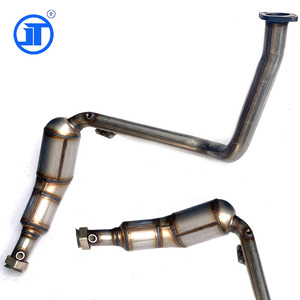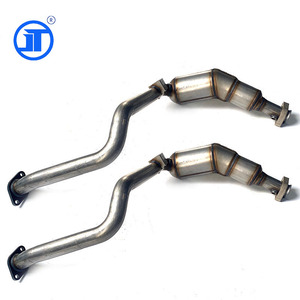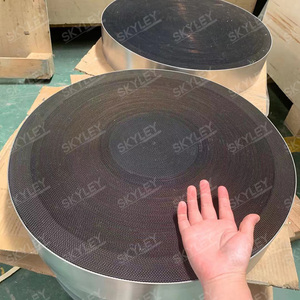Types of Sport Catalytic Converters
A sport catalytic converter is a specialized component used in high-performance or modified vehicles. Unlike standard catalytic converters, sports cats optimize exhaust flow while still reducing harmful emissions, resulting in increased horsepower and torque while maintaining environmental compliance.
Metal Substrate Converters
Constructed with high-strength metals like stainless steel for excellent durability and thermal shock resistance. Ideal for high-performance applications requiring reliability under extreme conditions.
Best for: Reliability, longevity, improved exhaust flow
Ceramic Substrate Converters
Made with ceramic materials (cordierite or alumina) coated with precious metals. Provide superior catalytic activity and high conversion efficiencies of harmful emissions.
Best for: Emission reduction, meeting strict regulations
High-Flow Converters
Designed with larger diameter pipes and fewer catalytic cells to minimize back pressure and maximize exhaust flow. Enable improved engine response and increased power output.
Best for: Performance enhancement, aftermarket modifications
Expert Tip: Racing catalytic converters are specialized variants engineered specifically for competitive motorsport. While they maximize performance by reducing back pressure to the minimum, they often aren't street legal due to reduced emission control. Always verify compliance with local regulations before installation.
| Converter Type | Performance Benefit | Emission Control | Durability | Best Application |
|---|---|---|---|---|
| Metal Substrate | Moderate | Good | Excellent | Daily drivers with performance mods |
| Ceramic Substrate | Low-Moderate | Excellent | Good | Emissions-focused performance builds |
| High-Flow | High | Moderate | Good | Tuned street cars |
| Racing | Maximum | Minimal | Variable | Track-only vehicles |
Specifications and Maintenance of Sport Catalytic Converters
Understanding the technical specifications of sport catalytic converters is essential for selecting the right component for your performance needs. These specifications directly impact both performance gains and emissions compliance.
Substrate Material
While standard converters typically use ceramic substrates, sport cats often utilize stainless steel construction. Metal substrates offer superior durability, corrosion resistance, and thermal properties ideal for high-performance applications.
Cell Density
Measured in cells per square inch (CPSI), this specification determines filtration efficiency versus flow restriction. Higher density (300-600 CPSI) provides better emissions control, while lower density (100-200 CPSI) offers improved exhaust flow for performance.
| Specification | Performance Impact | Emissions Impact | Typical Range |
|---|---|---|---|
| Material Composition | Moderate | High | Platinum, Palladium, Rhodium coatings |
| Flow Rate | High | Moderate | 20-40% higher than OEM |
| Cell Density | High | High | 100-600 CPSI |
| Operating Temperature | Moderate | High | 400-800°C optimal range |
| Emissions Standards | Low | Critical | Euro 4-6, EPA, CARB compliant options |
Maintenance Requirements
While sport catalytic converters require minimal maintenance compared to other performance components, proper care ensures optimal performance and longevity:
Important: Never use leaded fuels with any catalytic converter. Lead will permanently damage the precious metal catalysts, rendering the converter ineffective and potentially causing engine performance issues.
| Maintenance Task | Frequency | Importance | Notes |
|---|---|---|---|
| Visual Inspection | Every 6 months | Medium | Check for physical damage, corrosion, or leaks |
| Performance Testing | Annually | High | Monitor back pressure and emissions readings |
| Fuel Quality Management | Ongoing | Critical | Use only high-quality, unleaded fuel |
| Engine Tuning | After installation/modification | High | Ensure proper air/fuel ratios for optimal converter function |
| Heat Shield Inspection | Every 6 months | Medium | Verify heat shields are secure and undamaged |
Expert Advice: The biggest enemies of sport catalytic converters are extreme temperature fluctuations and improper engine tuning. A rich fuel mixture can cause carbon buildup, while an excessively lean mixture can lead to overheating and potential catalyst meltdown. Invest in proper engine tuning after installation to maximize both performance and converter lifespan.
How to Choose a Sport Catalytic Converter
Selecting the optimal sport catalytic converter requires carefully balancing performance objectives with practical considerations like compatibility and regulatory compliance. This comprehensive selection guide will help you identify the perfect sport cat for your specific needs.
Vehicle Compatibility
Sport catalytic converters are not universal - they must match your specific vehicle's make, model, and year. For example, a Nissan 350z (2003-2006) requires a converter designed specifically for that application to ensure proper fitment and function.
Critical Factor: Exact vehicle specifications
Engine Type Considerations
Different engine types have distinct emissions profiles and converter requirements. Diesel engines produce more particulate matter requiring specialized filtration, while gasoline engines typically benefit more from high-flow designs that optimize performance.
Critical Factor: Engine-specific catalyst formulation
| Selection Factor | What to Consider | Performance Impact | Legality Impact |
|---|---|---|---|
| Emissions Regulations | Local requirements (CARB, EPA, Euro standards) | Moderate | Critical |
| Performance Goals | Desired power gains vs. emissions compliance | High | High |
| Material Construction | Stainless steel for durability, specialized alloys for heat management | Moderate | Low |
| Size & Configuration | Diameter, length, inlet/outlet configuration | High | Moderate |
| Cell Count | Lower for performance (100-200), higher for emissions (300-600) | High | High |
| Brand Reputation | Quality control, warranty, customer support | Moderate | Moderate |
| Budget Considerations | Quality vs. cost tradeoffs | Variable | Variable |
Warning: Installing a non-compliant sport catalytic converter may be illegal in your jurisdiction. Many areas have strict emissions regulations with heavy fines for vehicles that don't meet standards. Always verify that your chosen converter meets local requirements before purchase and installation.
Expert Recommendation: For daily-driven performance vehicles, consider a high-quality 200-cell sport catalytic converter with stainless steel construction. This "sweet spot" typically offers a significant performance improvement (10-15 horsepower) while maintaining emissions compliance in most jurisdictions. Reserve 100-cell or "race" converters for competition-only vehicles.
DIY Installation Guide: Replacing a Sport Catalytic Converter
Installing a sport catalytic converter is a moderately challenging DIY project that can save hundreds in labor costs. With the right tools and careful attention to detail, most enthusiasts can complete this installation in 2-3 hours.
Required Tools & Materials
| Tool/Material | Purpose | Alternative |
|---|---|---|
| Jack and jack stands | Safely elevate vehicle | Vehicle ramp system (if available) |
| Lug wrench | Remove wheels (if necessary) | Impact wrench |
| Socket set with ratchet | Remove mounting bolts | Combination wrench set |
| Torx screwdriver set | Remove sensor attachments | Specialized Torx bits for socket wrench |
| Oxygen sensor socket | Remove O2 sensors | 22mm wrench (sometimes works) |
| Penetrating oil | Loosen rusted fasteners | WD-40 (less effective but workable) |
| New gaskets/hardware | Ensure proper sealing | No substitution (required) |
| Anti-seize compound | Prevent future bolt seizure | High-temp grease |
Step-by-Step Installation Process
Safety Warning: Exhaust components can cause severe burns even hours after the engine has been turned off. Always wear protective gloves and eye protection when working on exhaust systems. Additionally, ensure the vehicle is securely supported by proper jack stands before working underneath it.
Professional Insight: If your vehicle has a factory ECU, it may detect the changed exhaust flow characteristics of a sport catalytic converter and trigger a check engine light. While this doesn't always indicate a problem, consider having the ECU tuned or using an O2 sensor spacer to prevent false error codes.
Frequently Asked Questions About Sport Catalytic Converters
The answer depends on the specific converter and your local regulations. Many high-quality sport catalytic converters are designed to be emissions-compliant while still offering performance benefits. Look for converters that specifically state they are "CARB-approved" (California Air Resources Board) or "EPA-compliant" if passing emissions tests is a concern.
Some performance-oriented sport cats with very low cell counts (100 cells or less) may not meet stringent emissions standards. Always verify the manufacturer's emissions compliance claims before purchasing if road legality is important to you.
The primary differences between standard and sport catalytic converters are:
- Flow Rate: Sport cats typically feature larger internal diameters and less restrictive cell structures, improving exhaust flow by 20-40% over standard converters.
- Power Gains: Depending on the specific model and your vehicle, expect 5-15 horsepower increases and improved torque, particularly in the mid-range.
- Sound: Sport cats often produce a slightly more aggressive exhaust note without being excessively loud.
- Throttle Response: Reduced back pressure can improve throttle response and engine responsiveness.
The performance benefits are most noticeable on modified engines or vehicles with other performance upgrades already installed.
A quality sport catalytic converter installed on a properly maintained vehicle can last 50,000-100,000 miles (5+ years). Factors affecting lifespan include:
- Material quality and construction
- Engine tuning (running too rich or too lean accelerates deterioration)
- Driving habits (frequent high-temperature operation can reduce lifespan)
- Fuel quality (higher quality fuels with fewer impurities extend catalytic life)
Metal substrate sport cats typically outlast ceramic substrate versions when exposed to performance driving conditions due to their superior resistance to thermal shock and physical vibration.
Sport catalytic converters are largely maintenance-free, but following these practices will maximize their performance and lifespan:
- Use only high-quality unleaded fuel
- Keep your engine properly tuned to avoid running rich (excessive fuel) or lean (insufficient fuel)
- Allow your engine to reach operating temperature before aggressive driving
- Perform regular inspections for physical damage or exhaust leaks
- Address any check engine lights promptly, especially those related to oxygen sensors
Unlike some other performance parts, sport catalytic converters don't require periodic cleaning or adjustment when properly installed and operated.
Yes, sport catalytic converters can be installed on hybrid vehicles, but with important caveats:
- Hybrid-specific sport cats are necessary due to the unique operating characteristics of hybrid engines
- Emissions monitoring systems in hybrids are often more sensitive and may detect non-compliant converters
- The performance benefits may be less pronounced on hybrids that already have efficiency-optimized exhaust systems
- Installation may be more complex due to integrated hybrid system components
If considering a sport catalytic converter for a hybrid, consult with specialists who have experience with your specific hybrid model, as improper installation could affect both emissions compliance and the vehicle's complex control systems.


































































